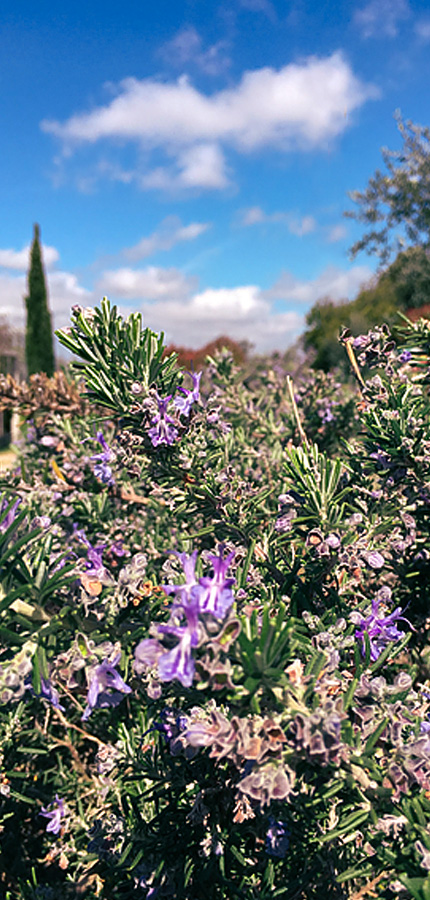Research and development
The company relies on collaborative relationships with research institutions and universities, which further support and validate the company’s production.
«Lots of attention, passion, curiosity and a lot of time. This is what leads us to control every single part of our production.», says the manager of èssenziale. «I am fortunate to have people who are attentive and precise in optimizing quality, minimizing the use of external products.» And then «continuous in-depth analysis, comparison, requests to universities and research centers. Let’s just say that we are always studying what we do so that we may continue learning. ». «We are constantly studying what surrounds us, how to give the best to the products that are requested».
Our raw materials, essential oils, and hydrolates not only represent the Tuscan territory but also have a bearing on a person's psycho-physical well-being.
Transformation and production
Thanks to the pomace, in practice what remains of the grape cluster once the pulp is removed, thus the skin and seeds.
We have begun to transform everything that could seem like a secondary or waste product like the pomace, from which, thanks to the seeds, we extract an oil of extraordinary properties, an essential ingredient of our cosmetic products.
From the harvest of thinning grapes we obtain Uvalife, a registered and trademarked product, rich in resveratrol, born after years of research with the University of Florence.
Tuscany is also the land of olive trees and from their leaves we create the Tesoro del Chianti. We collect the young shoots of the leaves and after a process of oxidative fermentation we are left with a product which, when used in infusion, maintains all of the properties of the plant without the classic bitter taste.

The circular supply to eliminate waste
We, like small embroiderers, take single, individual threads to make a new canvas. Let’s stop calling them scraps. There are many elements that make up a substance and many adjacent processes, and to achieve the squaring of a circle, a delicate balance is required. We take the hydrolates, grape seeds, the powder of the latter and we produce creams, soaps, shampoos.
The process for distilling medicinal herbs
We have selected and collected the most common aromatic herbs of the Tuscan territory, venturing out as far out as the Maremma, where the milder climate even in winter and the proximity to the sea enrich the plants with a unique, aromatic note.
Our goal is to extract the highest possible quality of essential oil contained in each plant, and simultaneously have an excellent hydrolate, through the steam distillation technique. The quality of the steam and its operating pressure have been calibrated so that there is a sort of gentle washing of the aromatic fragrances to be transmigrated. For this reason, it is important to know the balsamic point (the period in which the production of essential oil and aromatic principles is higher) of the individual essences and also the correct lunar phase to maintain the qualitative characteristics of the extracted oils unchanged, paying attention not to break the aromatic chains of the individual compounds. Above all else, maximum attention has been paid to the immediate processing of the plants, in other words, cutting and distilling on the same day.
Filtration of each oil produced follows distillation, and for some essences we also carry out some vacuum procedures in the extraction boiler, resulting in a more delicate removal of the active ingredients. Each individual batch of essential oil is left separated and cataloged in dark glass bottles. Depending on the type of essential oil, it may take several days before proceeding to olfaction, an operation that is useful for deciding whether or not to combine the products based on the type and origin of the soil.

The stages of distillation
To do this, we adopt several precautions: the very first is to cut the plants in the morning and distill them the same day, taking care not to break flowers and leaves from those varieties that can oxidize their compounds. Other precautions include the distillation temperature (never over 95°C inside the boiler) and the atmospheric pressure of the steam, which we keep at 0.4 atmospheres.
We know that in this way a percentage of product in the herbs is preserved, and these are the less noble oily products, which also carry unstable tannins. During the alchemical process of distillation, “The oil-bearing cells swell, the cell membrane tears under internal pressure, and the essence droplets are dispersed in the protoplasm exit to the outside where they volatilize.”
Immediately after distillation, each oil is filtered to immediately remove waxes and particles that may have been inadvertently extracted during the process. For some essences, we also perform vacuum procedures. In the extraction boiler, this system lowers the extraction temperatures and times, resulting in a more delicate removal of active ingredients.
Each batch of essential oil is kept separate and cataloged in dark glass bottles. Depending on the type of essential oil, several days pass before performing olfactory evaluation, which helps decide whether to combine products based on their type and the origin of the soil.
Once the batches are obtained, we send samples to the lab for gas chromatography of the aromatic spectra of the individual elements. This data is mainly used to compare different harvest years and to assess how to improve the quality of extracted products.
There are many reasons that a product varies: it may depend on the maturity of the flowers, leaves, or berries from which we extract the active ingredients, but also on the light, heat, and water the plants receive or the harvest time. Many factors lead to obtaining different products.
